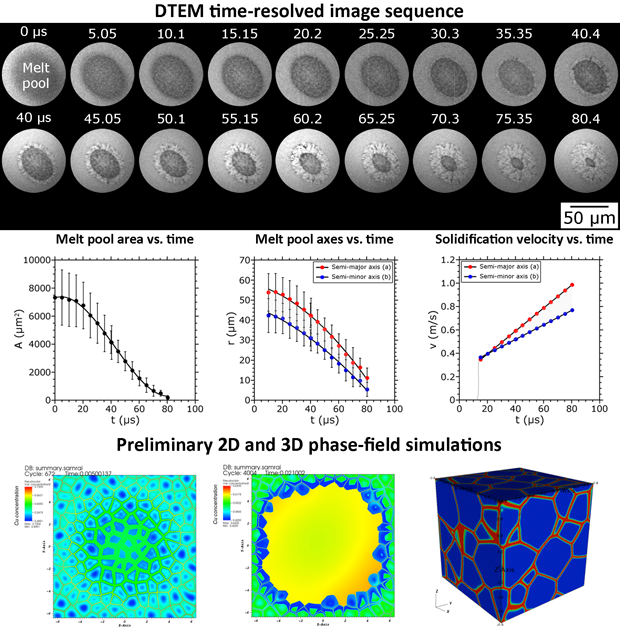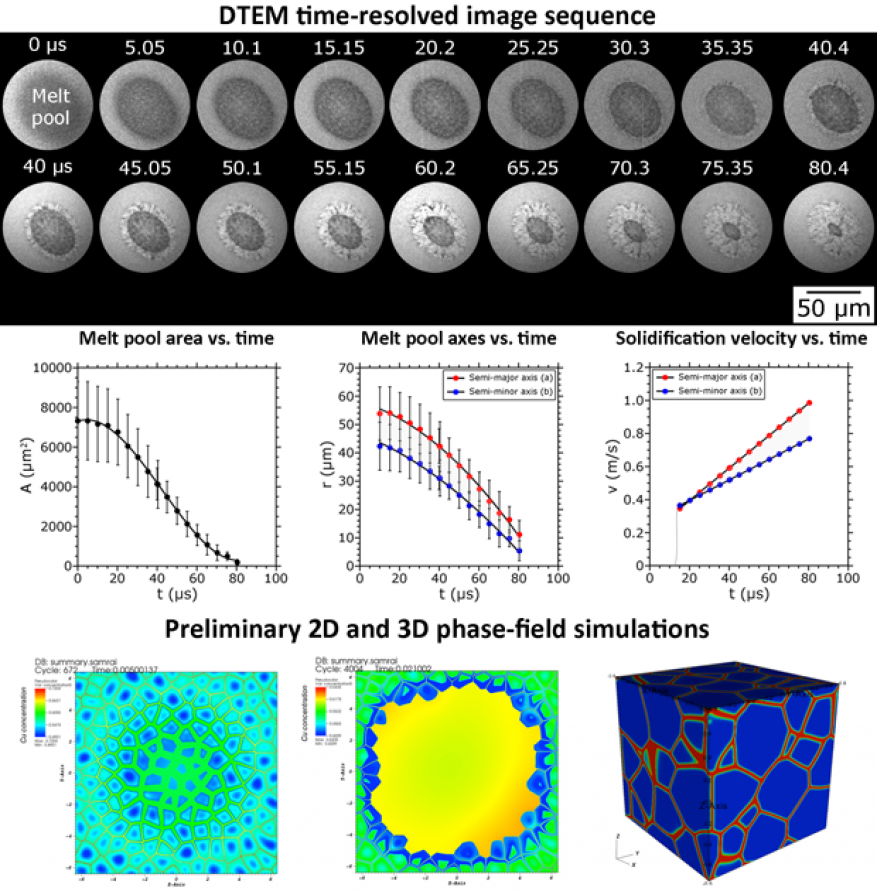Joseph Mckeown (15-ERD-006)
Project Description
Materials properties govern performance in programmatic and industrial applications. Properties, in turn, are dictated by microstructure—specifically, the arrangement of phases and defects in a material. Microstructural control through materials selection and processing is therefore essential to engineering applications of any manufactured component. Additive manufacturing with rapid solidification from high cooling rates can produce metal and alloy parts with promising microstructures and properties that differ significantly from those of conventional cast and wrought components. However, there is currently a lack of in situ experimental insight into microstructure evolution and kinetics during rapid solidification, which is crucial for predictive modeling capabilities to improve high-throughput materials development based on additive manufacturing. Our objective is to establish the fundamental scientific knowledge of rapid solidification to predict nonequilibrium microstructure for additive manufacturing processes. We will perform experiments using dynamic transmission electron microscopy to monitor microstructure evolution and measure kinetics during rapid solidification. By integrating experiments with simulations, we will develop a validated model for solidification under extreme conditions of laser melting that can be applied across materials systems.
We expect to enable a predictive capability for nonequilibrium microstructure for a variety of advanced (and, in particular, additive) manufacturing processes. We will conduct experiments to quantify kinetics and microstructural evolution of rapid solidification, while systematically varying alloy complexity, composition, thermal gradient, and viscosity, to fully characterize laser-induced processes experienced by alloys during additive manufacturing. Theory and simulations will produce validated predictive modeling capabilities for solidification under extreme, far-from-equilibrium conditions. Our results will help guide the design of desired microstructures and post-thermal treatment for improved materials performance, providing an accelerated path to practical applications.
Mission Relevance
Advanced materials characterization coupled with validated predictive modeling will provide the fundamental knowledge of microstructure evolution under extreme conditions. This capability supports the advanced materials and manufacturing core competency for the Laboratory's strategy relevant to addressing scientific and engineering challenges of accelerating the design, fundamental understanding, and deployment of new materials and manufacturing processes. In addition, this effort contributes to stockpile stewardship science to meet NNSA's current and future national security requirements related to the design of materials with tailored properties as part of cost-efficient, timely approaches to warhead life-cycle support with new capabilities.
FY16 Accomplishments and Results
During FY16, our experimental effort focused on alloy systems with lower melting temperatures to facilitate data acquisition and provide critical input data to modeling efforts (see figure). Specifically, we (1) obtained dynamic transmission electron microscopy data sets of copper–nickel and silver–copper alloys, and characterized their microstructures before and after laser melting and re-solidification; (2) performed single laser-track experiments with bulk niobium–titanium and copper–nickel alloys for comparison with dynamic transmission electron microscopy data and spanning a larger range of solidification velocities, with characterization of the laser-track microstructures; (3) performed in situ dynamic transmission electron microscopy and ex situ laser-track experiments exploring the effects of thermal gradient on rapid solidification, and explored new techniques for further dynamic transmission electron microscopy experiments with the high-melting-temperature alloys niobium–titanium and niobium–zirconium; (4) validated thermodynamic and kinetic data for silver–copper, aluminum–copper, aluminum–silicon, aluminum–zinc, and copper–nickel alloy systems; (5) performed one-dimensional interface velocity simulations with DICTRA (a diffusion-controlled transformation code for simulation of diffusion-controlled reactions in multiple-component alloy systems) for copper–nickel at various cooling rates, and determined the effects of cooling rate on the alloy's interface composition; (6) compared one-dimensional velocity simulations using DICTRA and AMPE (a phase-field code) for niobium–zirconium and copper–nickel, and two-dimensional AMPE simulations for copper–nickel, and obtained three-dimensional AMPE results for the initial rapid solidification stage in copper–nickel; (7) developed two- and three-dimensional predictions of microstructure evolution of the crystalline phase of niobium–titanium and copper–nickel behind a melt pool; (8) explored the pertinence of transformation diagrams in the context of rapid solidification; and (9) derived new equations to account for the diffusion-free assumption that pertains to rapid solidification, and implemented these equations in the phase-field code.
Publications and Presentations
- McKeown, J. T., et al., Microstructure evolution during laser-induced rapid alloy solidification. Minerals, Metals and Materials Soc. 145th Ann. Mtg. and Exhibition, Nashville, TN, Feb. 14–18, 2016. LLNL-ABS-673658.
- Perron, A., et al., Combining calphad-informed phase-field modeling with rapid solidification experiments for prediction of microstructure evolution during laser-based additive manufacturing. TMS 146th Ann. Mtg. and Exhibition, San Diego, CA, Feb. 26–Mar. 2, 2017. LLNL-ABS-697762.
- Perron, A., et al., Solidification across the multi-scale landscape. 8th Intl Conf. Multiscale Materials Modeling, Dijon, France, Oct. 9–14, 2016. LLNL-PROP-677182.
- Roehling, J. D., et al., In situ characterization of rapid alloy solidification using dynamic transmission electron microscopy. Advanced Qualification of Additive Manufacturing Materials, Santa Fe, NM, July 20–21, 2015. LLNL-ABS-673659.
- Roehling, J. D., et al., Progress toward predicting rapidly solidified microstructures of metallic alloys. TMS 146th Ann. Mtg. and Exhibition, San Diego, CA, Feb. 26–Mar. 2, 2017. LLNL-ABS-696619.
- Roehling, J. D., et al., Toward predicting rapidly solidified microstructures of metallic alloys. Materials Science and Technology, Salt Lake City, UT, Oct. 23–27, 2016. LLNL-ABS-685977.
- Turchi, P. E. A., Microstructure modeling in support of additive manufacturing. Federal Institute of Materials Research and Testing (BAM), Berlin, Germany, Jan. 18–19, 2016. LLNL-ABS-680841.
- Turchi, P. E. A., "Old time"—present—future of computational materials science. Federal Institute of Materials Research and Testing (BAM), Berlin, Germany, Jan. 18–19, 2016. LLNL-ABS-680842.







